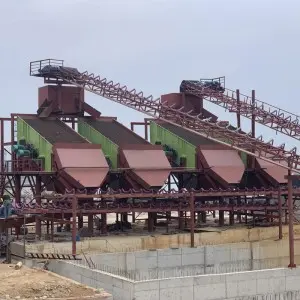As an important piece of equipment on industrial production lines, the stability and low-noise operation of vibrating feeders are crucial for ensuring production efficiency and the health of operators. However, after long-term operation, the vibrating feeder may encounter the problem of excessive noise, which not only affects the working environment but also may lead to a decline in equipment performance. This article will explore the reasons for excessive noise in vibrating feeders and the corresponding maintenance measures.
First, analysis of the causes of excessive noise
Excessive noise from the vibrating feeder may be caused by the following reasons:
Bearing wear: Bearings are one of the core components of vibrating feeders. Long-term operation may lead to bearing wear, thereby generating abnormal noise.
Loose fasteners: If the fasteners of the vibrating feeder are loose, it may cause impact and vibration between components, thereby generating noise.
Imbalance: If the rotor of the vibrating feeder is unbalanced, it will generate additional vibration and noise during operation.
Insufficient lubrication: Lack of proper lubrication can lead to increased friction between components, thereby generating greater noise.
Internal damage: If the internal components of the vibrating feeder, such as springs and shock absorbers, are damaged, it may also cause noise problems.
Second, maintenance measures
In response to the above reasons, the following maintenance measures can be taken:
Inspect the bearings: Regularly check the wear of the bearings and replace them if necessary. Ensure that the bearings are properly lubricated to reduce friction and wear.
Fastening components: Check if all fasteners are tight. If any are loose, tighten them immediately to prevent noise caused by component impact.
Balance adjustment: Conduct dynamic balance tests on the rotor of the vibrating feeder and make adjustments if necessary to reduce vibration and noise during operation.
Lubrication maintenance: Ensure that all moving parts of the vibrating feeder are fully lubricated to reduce friction and wear and lower noise.
Internal inspection: Regularly conduct detailed inspections of the interior of the vibrating feeder, identify and repair or replace damaged components.

Third, preventive maintenance
In addition to the above-mentioned maintenance measures, the following preventive maintenance measures should also be taken to reduce the problem of excessive noise:
Regular maintenance: Develop a regular maintenance plan, including cleaning, lubrication and inspection, to prevent problems from occurring.
Operation training: Provide appropriate training to the operators to ensure they understand how to operate and maintain the vibrating feeder correctly.
Environmental monitoring: Install noise monitoring equipment around the vibrating feeder to promptly detect and handle noise issues.
Improve the design: If possible, consider improving the design of the vibrating feeder, such as using higher-quality materials or more advanced shock absorption technologies.
Fourth, Conclusion
Excessive noise from vibrating feeders is a common but solvable problem. Through regular inspection of bearings, fastening components, balance adjustment, lubrication maintenance and internal inspection and other maintenance measures, as well as taking preventive maintenance measures, the noise of vibrating feeders can be effectively reduced, their operational efficiency can be improved and the working comfort of operators can be enhanced. Through these methods, the long-term stable operation of the vibrating feeder can be ensured, providing reliable support for production.
Post time: Jun-26-2025
